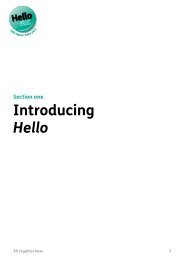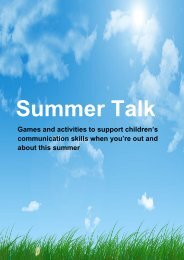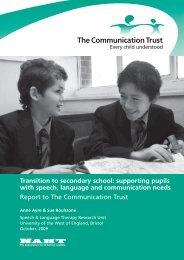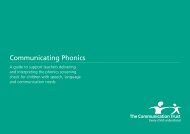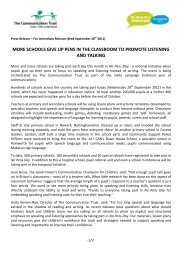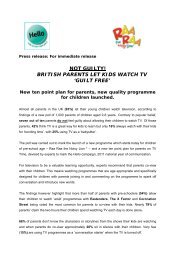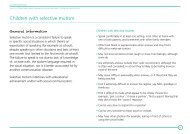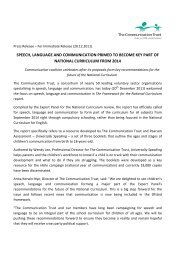Listen Up - The Communication Trust
Listen Up - The Communication Trust
Listen Up - The Communication Trust
Create successful ePaper yourself
Turn your PDF publications into a flip-book with our unique Google optimized e-Paper software.
<strong>Listen</strong> <strong>Up</strong>Being able to communicate is notjust about talking.Along with getting your own message across,being able to listen, pay attention, interact,play and understand what’s being said are thefundamental building blocks of communication.This pack explains more about these importantskills and contains lots of activities to helpyou and your child. This can help them learn,make friends and have fun.<strong>Communication</strong> Development PyramidSpeechSoundsInteraction and TalkingUnderstandingPlayAttention and <strong>Listen</strong>ingAdapted from a model used in many speech and language therapy services across the UK
Hello.2011 is the national year ofcommunication.<strong>The</strong> Hello campaign is here to supportyou in helping your child develop theircommunication. Find out more atwww.talkingpoint.org.ukTo get involved in Hello go towww.hello.org.uk
School AgeActivitiesUsing the fortune teller provided, have yourchild put their fingers in the spaces and getready to play.Choose a number and your child opens andcloses the fortune teller that many times.<strong>The</strong>n, choose a colour and open and closethe fortune teller to the number of letters inthat colour e.g...b..l..u..e(4)
Choose a colour again and this time open upthe flap – under the flap will be either the wordplay,interaction,understanding orlistening.You choose a card with the same word andcolour and get your child to carry out theactivity.You can play as many or few of the activitiesas you have time for and can take turnsholding the fortune teller.You can set aside some time to play thesegames with your child or take the pack ona long journey or when needing to wait forappointments to make the time less boring.
InteractionWe communicate and interact with eachother in different ways; learning theskills of interaction is really important forhaving good conversations.We need to learn when to talk and whento listen, how to take turns, how to noticeif someone is not listening or bored withwhat we’re saying. We need words to dothis, but also skills in looking, listeningand noticing people around us.Children learn from adults by watching howthey interact with other adults and withchildren.
InteractionWhat is different?Get your child to look at you carefully andthen ask them to close their eyes.While they are not looking, changesomething about your appearance, likerolling up your sleeves, messing up your hairor putting on some glasses.Can they spot what is different?
InteractionFavourite thingsPlay a game sharing ideas of favouritethings. Ask your child what their favouritesare and tell them yours.• My favourite food is...• My favourite TV programme is...• My favourite day is...• My favourite book is...• My favourite sport is...
InteractionThree good thingsShare some time with your child to talkabout what they have enjoyed in their day.A good way to do this is to ask:“Can you think of 3 good things you didtoday?”Share with them good things that havehappened in your day.
InteractionCharadesGet your child to play charades. Write downthe words and phrases below on separatepieces of paper. Your child chooses one andacts it out for you to guess.• <strong>The</strong> film <strong>The</strong> Lion king• Batman• <strong>The</strong> book character Harry Potter• Spiderman• A tiger
PlayPlay is a really important part ofchildren’s learning and development.Children learn all kinds of skills throughplay; they learn how things work, how tointeract and share with other children,how to play with different toys and toenter a world of imagination.Playing enables children to test thingsout in a safe way, to learn aboutemotions and to talk with others.Children often love adults to play withthem. It’s great if you can follow theirlead and join in the fun.
PlayPicture timeHave fun making a squiggly picture together.One of you draws a squiggly line and thenthe other person adds to it to turn it into apicture.<strong>The</strong> first person adds a bit more and so on...until you are all happy with the picture.Talk about what you have created.
PlayStory timeTake turns to add different parts of a story soyou build a story together:• <strong>The</strong>re was once a...• Who lived...• He decided to...• He met a...• <strong>The</strong>y went to...• <strong>The</strong>n something amazing happened...• So then they....• And in the end...
PlayI’m going to the seaside...In this game, the rule is you can only takesomething to the seaside if it begins with theletter “s”.Take turns – “I’m going to the seaside andI’m going to take my scooter”... “I’m going tothe seaside and I’m going to take my socks”...“I’m going to the seaside and I’m going totake my...”Keep going until you run out of ideas orsomeone makes a mistake, then change theletter if you want to play again.
PlaySentence startersYou begin a sentence and someone elsefinishes it. Decide whether it’s silly orsensible:• Chicken is my favourite...• One day I ate an enormous...• In my garden I saw a...• I won an amazing...• <strong>The</strong> clown I saw was juggling...
UnderstandingUnderstanding is key to talking and learning.Children need to understand what singlewords mean and when words are joinedtogether into sentences, conversationsand stories. This takes time and childrengo through phases where they ask lots ofquestions.This is a good thing as they’re trying to findout how things work and understand theworld around them.Adults play an important role in answeringthe many questions children have and inchecking out whether children understand.
UnderstandingRiddlesTell riddles and see if your child can guessthe answer:• It’s an animal, it has stripes, it’s black andwhite...• It’s a food, it’s round, it’s crunchy, it growson trees, it begins with “a”• You use it to eat with, it has a round bit atthe end, you can stir your tea with it...• You can use one of these if you make amistake, they don’t work on pen, it startswith “r”• You can watch this, you can play it, youneed a ball and you score goals...
UnderstandingOdd one outWhich is the odd one out of the following:• Sheep, cow, chicken, lion• Apple, orange, grapes, carrot• Chair, table, sofa, hat• Cabbage, yoghurt, potato, broccoli• Football, rugby, judo, cricket
UnderstandingJabber jabberThink of a sentence for the following words,but replace the words with jabber jabber.Can your child guess the word?Hat - you wear a jabber jabber on your headCook – I like to jabber jabber my dinnerSchool – I love coming to jabber jabberSwing – the jabber jabber is my favouritething in the parkSwim – my friend Joe can jabber jabber likea fish
UnderstandingSpot the mistake/true or false• Christmas is in November• Leopards run as fast as mice• <strong>The</strong> leaves fall off the trees in spring• Eating lots of sugar is good for you• Sheep lay eggs
<strong>Listen</strong>ing<strong>Listen</strong>ing is an essential skill for talkingand learning.Everywhere we go there are differentnoises around us. Sometimes childrenneed a bit of quiet time to help themtune into talking rather than the othernoises going on around them.Adults need to show children the way– when we listen to children, they learnwhat to do in order to be good listeners.
<strong>Listen</strong>ingRhyming riddlesI leave a trailI am not a whaleI have a shellI am a...My tail is bushyI don’t wear socksI live in the woodsI am a...I have some furI am not a ratI say meowI am a...
<strong>Listen</strong>ingRhyming cluesGive clues about different things thatrhyme...there might be more than one rightanswer.• It’s a part of your body, it rhymes with bed• It’s something you eat, it rhymes withpyjamas• It’s something you ride in, it rhymes withthroat• It’s an animal, it rhymes with peep• It’s an insect, it rhymes with wider
<strong>Listen</strong>ingCrazy talkSay a sentence with a deliberate mistake– can your child listen and correct themistake?• I love eating coal and chips• My school is made of chocolate chips andbricks• Maths is great, we do times chairs• My mum likes beetles in her tea• Saturday is the best day at school
<strong>Listen</strong>ingDressing upTell a story about dressing up – you have tolisten and remember exactly what is worn.I am going to wear my big red shoes, purplespotty trousers, a yellow shirt and a redbow tie and on my head a green hat with afeather on top.What am I wearing?



